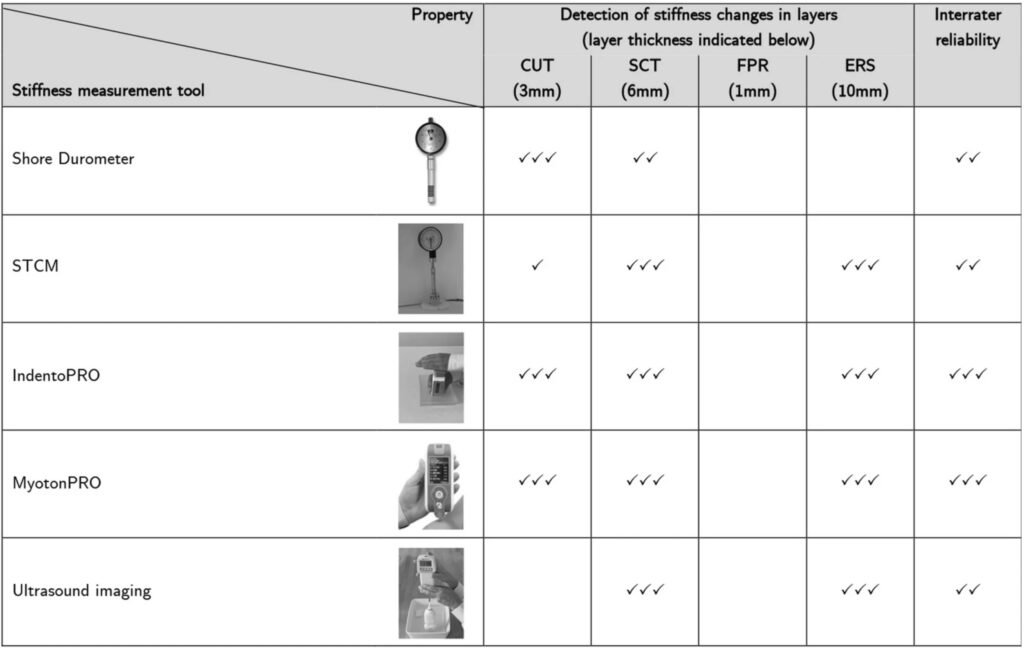Publications

Assessing reliability and validity of different stiffness measurement tools on a multi‐layered phantom tissue model
Authors: Katja Bartsch 1, 2, Andreas Brandl 3, 4, 5, Patrick Weber 6, Jan Wilke 7, 8, Sabine F. Bensamoun 9, Wolfgang Bauermeister 10, Werner Klingler 2, 11, 12, Robert Schleip 2, 4, 12
Affiliations:
- Department of Sport Science and Sport, Friedrich-Alexander Universitat Erlangen-Nurnberg, Erlangen, Germany
- Conservative and Rehabilitative Orthopedics, Department of Sport and Health Sciences, Technical University of Munich, Munich, Germany
- Department of Sports Medicine, Faculty for Psychology and Human Movement Science, Institute for Human Movement Science, University of Hamburg, Hamburg, Germany
- Department for Medical Professions, Diploma Hochschule, Bad Sooden-Allendorf, Germany
- Osteopathic Research Institute, Osteopathie Schule Deutschland, Hamburg, Germany
- Department for Physical Activity in Public Health, Institute of Movement and Neurosciences, German Sport University Cologne, Cologne, Germany
- Department of Movement Sciences, University of Klagenfurt, Klagenfurt, Austria
- Institute of Occupational, Social and Environmental Medicine, Goethe University, Frankfurt, Frankfurt/Main, Germany
- Universite de Technologie de Compiegne, CNRS UMR 7338, Biomechanics and Bioengineering Laboratory, Sorbonne University, Compiegne, France
- Charkiv National Medical University, Charkiv, Ukraine
- SRH Hospital, Sigmaringen, Germany
- Experimental Anaesthesiology, Ulm University, Ulm, Germany
Journal: Nature - Scientific Reports - January 2023, Volume 13, Article no. 815 (DOI: 10.1038/s41598-023-27742-w)
-
Field & Applications:
- Medical
- Reliability
- Validity
- MyotonPRO stiffness (N/m) showed the highest correlations throughout all devices, amounting to 0.94 for changes in CUT, 0.98 for SCT and 0.91 for ERS. Interrater reliability for MyotonPRO was excellent throughout all MPTM layers (0.98 for CUT, 0.99 for SCT, 0.94 for ERS).
Changes in the mechanical properties (i.e., stiffness) of soft tissues have been linked to musculoskeletal disorders, pain conditions, and cancer biology, leading to a rising demand for diagnostic methods. Despite the general availability of different stiffness measurement tools, it is unclear as to which are best suited for different tissue types and the related measurement depths.
The study aimed to compare different stiffness measurement tools’ (SMT) reliability on a multi-layered phantom tissue model (MPTM).
A polyurethane MPTM simulated the four layers of the thoracolumbar region: cutis (CUT), subcutaneous connective tissue (SCT), fascia profunda (FPR), and erector spinae (ERS), with varying stiffness parameters. Evaluated stiffness measurement tools included Shore Durometer, Semi-Electronic Tissue Compliance Meter (STCM), IndentoPRO, MyotonPRO, and ultrasound imaging. Measurements were made by two independent, blinded examiners.
Shore Durometer, STCM, IndentoPRO, and MyotonPRO reliably detected stiffness changes in three of the four MPTM layers, but not in the thin (1 mm thick) layer simulating FPR. With ultrasound imaging, only stiffness changes in layers thicker than 3 mm could be measured reliably. Significant correlations ranging from 0.70 to 0.98 (all p < 0.01) were found. The interrater reliability ranged from good to excellent (ICC(2,2) = 0.75–0.98).
The results are encouraging for researchers and clinical practitioners as the investigated stiffness measurement tools are easy-to-use and comparatively affordable.

Figure 3. CUT cutis. SCT subcutaneous connective tissue. FPR fascia profunda. ERS erector spinae. Blank denotes “no reliable measurement possible”. ✓ denotes moderate correlation (> 0.4). ✓✓ denotes strong. correlation (> 0.7). ✓✓✓ denotes very strong correlation (> 0.9). Photos (1st to 5th row): rows 1–3: fasciaresearch.org with permission; myotonpro.com with permission, fasciareasearch.org with permission.
To our knowledge, this is the first study examining the reliability of the Shore Durometer, STCM, IndentoPRO, MyotonPRO, and ultrasound with force transducer on a MPTM mimicking different tissue layers of the human low-back region. The Shore Durometer, STCM, IndentoPRO and MyotonPRO reliably detected stiffness changes in three of the four MPTM layers. With the ultrasound method, only stiffness changes in layers thicker than 3 mm (i.e., SCT and ERS) could be measured reliably. No method could detect stiffness changes in the thin (1 mm) layer simulating the FPR.
The indentation and myotonometry devices included in this study are easy-to-use, with analog or digital displays allowing for an immediate reading of the stiffness-related measurement results. In addition, they are comparatively low in price.


